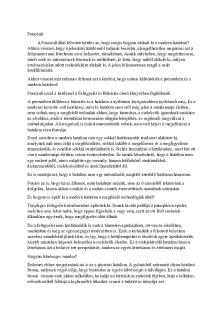Michel foucault- Microphysics of power PDF

| Title | Michel foucault- Microphysics of power |
|---|---|
| Author | Daniele Horaguti |
| Course | Mental Health Therapy |
| Institution | University of Essex |
| Pages | 3 |
| File Size | 39.5 KB |
| File Type | |
| Total Downloads | 83 |
| Total Views | 158 |
Summary
Microphysics of Power is a book based on texts by author Michel Foucault with
organization, introduction and technical revision by Roberto Machado, published by
Edições Graal LTDA and printed in Brazil in 2003. This work is divided into seventeen
chapters organized into two hundred...
Description
microphysics of power
BIBLIOGRAPHIC REFERENCE Foucault, M. Microphysics of power. São Paulo: Graal, 2003. p. 99-128.
PRESENTATION OF THE WORK Microphysics of Power is a book based on texts by author Michel Foucault with organization, introduction and technical revision by Roberto Machado, published by Edições Graal LTDA and printed in Brazil in 2003. This work is divided into seventeen chapters organized into two hundred and seventy and seven pages, the content reviewed will be from chapters six and seven, which talk about the role of the hospital as a therapeutic tool from the end of the eighteenth century (eighteen) and also about the role of the insane in asylums through historical facts and practices scientific.
WORK SUMMARY The hospital as a therapeutic tool emerged at the end of the 18th century, this awareness that the hospital is intended for cure is marked by visits and systematic observation and comparison between hospitals. Between 1775 and 1780, survey trips took place in Europe with the purpose of developing a program for the reform and reconstruction of hospitals, after empirical investigations, and thus they would be more than architectural figures. These investigations focused more on the clinical and internal structural part than on the external structure of the building, Howard and Tenon, precursors of these trips, calculated the relationship between the number of beds and the number of patients and the hospital's territorial area. Tenon also conducted research on the relationships between pathological and spatial phenomena, such as,
According to the author Foucault (2003), the role of hospitals prior to this fact at the end of the 18th century was completely the opposite, instead of curing it was considered a deposit of poor and sick people who would soon die right there,
hospital professionals were religious, lay people or people who wanted to show charity and thus ensure their eternal salvation. That said, the hospital institution had nothing to do with medical practice in itself, it was just a place of exclusion, assistance and spiritual transformation of the poor, medicine was individualistic and doctors were qualified based on the amount of prescriptions prescribed, their practice was observe the patient and his illness until reaching the critical point and try to predict what the cure would be.
The hospital was medicalized and medicine became a hospital from the moment the hospital's negative effects were annulled and the discipline that has the power to control actions such as inspection systems was eliminated. This theory can be confirmed through the largest hospital organization in Europe located mainly in maritime and military hospitals, which became models for the reorganization of hospital institutions using discipline as a technique of power. Therefore, the adaptation of the process of displacement of medical practice and disciplining the hospital space provided the birth of the medical hospital, and from that moment it is a healing instrument, a therapeutic instrument and doctors are responsible for the organization and monitoring, consequently, A permanent recording system of incoming and outgoing patients, diagnoses and also death or cure is created, this through a small tag attached to the patient's wrist. This system imposed on the institution totally changes the power that was previously in the hands of the religious to the hands of the doctors (FOUCAULT, 2003).
The psychiatric hospital of the 19th century determines a function that, at the same time, was one of diagnosis and classification of diseases, it was also a closed institutional space where it was a question of victory and submission. Therefore, the psychiatric doctor receives the institution's power over the inpatient, since the professional has scientific knowledge and is competent. Given this relationship of power, the anti-psychiatry movement was born, which said that doctors were the cause of madness and hysteria. This movement goes against the power that the doctor has over the crazy patient, who has no rights, and at the same time hospital professionals held the power over this patient (FOUCAULT, 2003).
The demedicalization of madness is completely related to the questioning of power in antipsychiatry practice, which in turn intends to give the individual the right to carry out their madness without associating with reason or normality, freeing them from a pathological classification that exercised control over their lives ....
Similar Free PDFs

El Vocabulario De Michel Foucault
- 608 Pages

Michel Foucault fiche de lecture
- 3 Pages

Foucault-Truth and Power
- 11 Pages

Foucault
- 3 Pages
Popular Institutions
- Tinajero National High School - Annex
- Politeknik Caltex Riau
- Yokohama City University
- SGT University
- University of Al-Qadisiyah
- Divine Word College of Vigan
- Techniek College Rotterdam
- Universidade de Santiago
- Universiti Teknologi MARA Cawangan Johor Kampus Pasir Gudang
- Poltekkes Kemenkes Yogyakarta
- Baguio City National High School
- Colegio san marcos
- preparatoria uno
- Centro de Bachillerato Tecnológico Industrial y de Servicios No. 107
- Dalian Maritime University
- Quang Trung Secondary School
- Colegio Tecnológico en Informática
- Corporación Regional de Educación Superior
- Grupo CEDVA
- Dar Al Uloom University
- Centro de Estudios Preuniversitarios de la Universidad Nacional de Ingeniería
- 上智大学
- Aakash International School, Nuna Majara
- San Felipe Neri Catholic School
- Kang Chiao International School - New Taipei City
- Misamis Occidental National High School
- Institución Educativa Escuela Normal Juan Ladrilleros
- Kolehiyo ng Pantukan
- Batanes State College
- Instituto Continental
- Sekolah Menengah Kejuruan Kesehatan Kaltara (Tarakan)
- Colegio de La Inmaculada Concepcion - Cebu











